Solar-powered, wood-fired, Japanese-inspired

I love the tradition of the Japanese Bath. The ritual of slowly washing and soaking in a calm and beautiful setting, a cleansing of the mind and the heart as opposed to merely washing the body.
Our bath house is a vision I've had since we started the farm, in fact it's heartbeat, the Chofu wood-fired hot tub heater, is the first thing I purchased for our land once we decided to commit to buying the property. Literally the very first thing. While consumed with the neccessary projects of getting the farm up and running, I quietly collected materials, not quite knowing how they would all fit together. Permaculture farming is the art of watching the land and learning how you can use the natural flows of water, sunshine, shade, and nutrients to grow food, in essence working with the land as opposed to a heavy handed approach of imposing your will upon it. The same principles apply to architecture. Watching how people use space one learns how to meet those needs without indiscriminantly dumping cash onto the problem.
Cedars blow down in a windstorm on a friends' property and I peel them and carry them out of the woods. A bunch of 3x3's wash up on the beach and I spend weeks carrying them one by one, destined to become rafters for the roof. Three twenty-year old solar hot water panels arrive at the dump and I buy them for the price of scrap. A plain fiberglass soaking tub is bought at the recycle center for fifty dollars. While fishing for salmon I notice a new cedar log and tie it up to be floated in the next winters flood. The winter after that I mill it into boards, and the next winter I make it into shiplap siding and nail it up inside the sauna. I try to salvage as much as I can. If each piece has a story, then the structure has meaning, it has a soul.
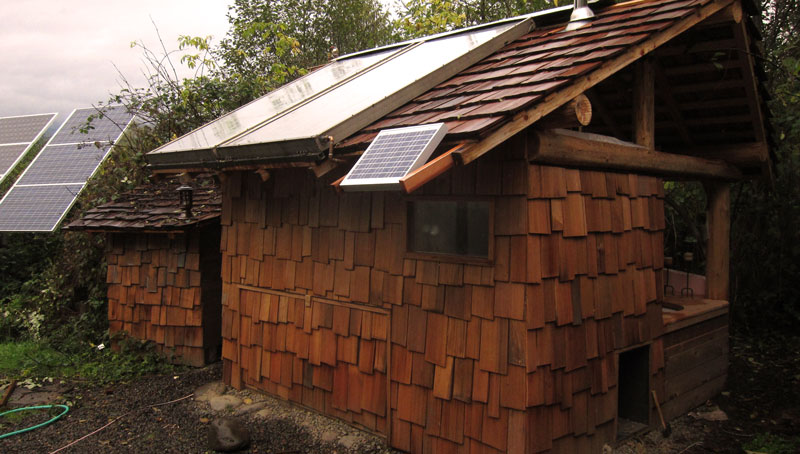
The frame of the structure is notched and bolted cedar poles sitting on an 11'x11' stained concrete pad. Rafters are 3x3's with cedar shakes nailed directly onto spaced sheathing boards. The front half of the pole-frame is infilled with 2x6's, covered with plywood and cedar shakes. This enclosed area creates a room that houses the plumbing for the solar loop, the wood-fired hot tub heater, and provides a small warm sitting area. The interior is filled with plain fiberglass recycled from another project, and covered with a heavy foil vapor barrier, over which I nailed home-milled shiplap cedar boards. The rectangle you see in the bottom of the front wall is a horizontal door that opens to reveal a window that admits sunlight to warm the room in the summer months. The two panels on the roof are old solar hot water panels, and the little photovoltaic panel powers a small pump that pumps water up through those panels when the sun is shining. The panels are drained manually on freezing nights. The tub sits in the open air at the back of the structure. The tiny building you see to the left is a composting toilet.
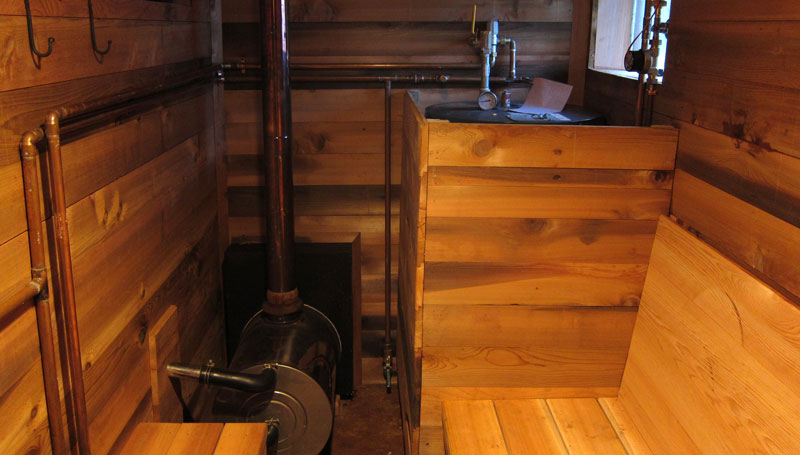
The heating system is a bit of a science project. In the lower left corner you see a Chofu water-jacketed wood-fired hot tub heater that operates on the simple principle of thermo-syphon. It is not a pressurized system and can only be used to heat water in the tub. To the right is a burned-out old 50 gallon hot water heater. This stores the hot water made by the solar panels. I chose to leave all of the copper plumbing exposed because I think it's attractive and it makes an excellent teaching tool. Where I took the photo from there is seven feet of benches to sit on and relax.
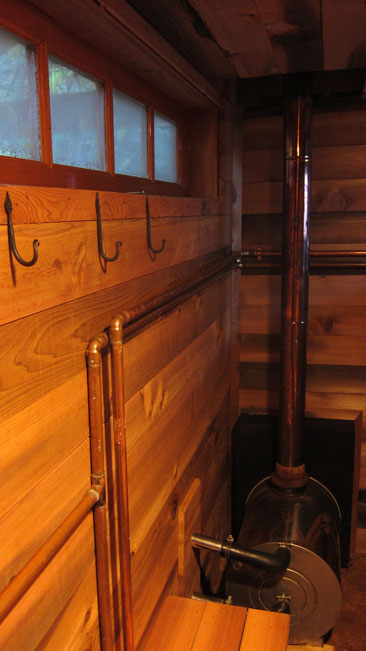
A closer look at the Chofu. By elbowing the Chofu through this space, the waste heat from the chimney is captured and warms the room. This works very well and heats this 5'x11' room to 90 degrees in one hour. With an insulated floor and less windows, the waste heat from the Chofu could easily heat a slightly smaller space to sauna temperatures. It's important to note that the Chofu is NOT designed for this type of use and I took great pains to insure that I had wide clearances for the single-wall stainless steel chimeny which routinely turns cherry red. I also bolted it in place and caulked and gasketed the firebox opening, to make sure that no smoke could enter the building. The normal draft-collar is sealed off as well. For safety I installed a carbon monoxide detector just to make sure.
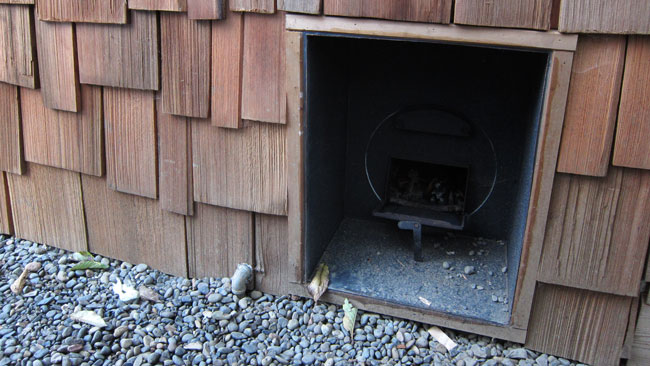

A couple views of the Chofu from the outside. The steel box was custom fabricated to inset the stove to allow safe chimney clearances. Nine inches is a minimal clearance here and if this were in a living area I would make it twelve inches with a heat shield. This setup is a brilliant use of the significant waste heat that the Chofu creates but it's also risky and need to be carefully constructed.
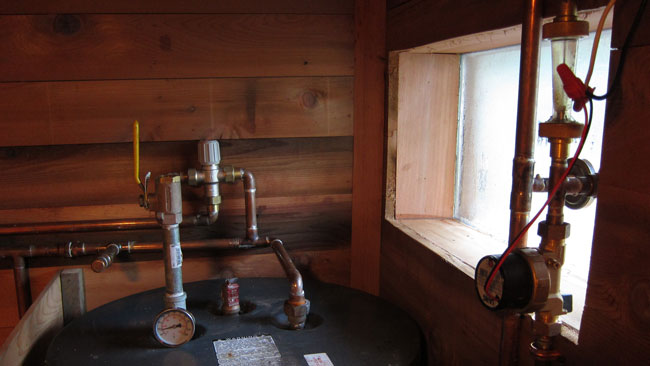
A more detailed view of the tank plumbing. The normal hot and cold ports are used to supply the bath with the important addition of a tempering valve (left middle) that lets cold water mix with the hot when a tap is turned on. This is very important in solar applications where the tank temperature may rise to boiling and could badly scald bathers. On the right side you see a Laing Photovoltaic Direct Circulating Pump, which begins pumping water through the solar hot water array as soon as the sun hits the photovoltaic panel outside. Above the pump is a Blue-White flow meter. Throughout the entire system there are meters and temperature gauges. While not strictly neccessary I enjoy watching the flows and tempertatures.
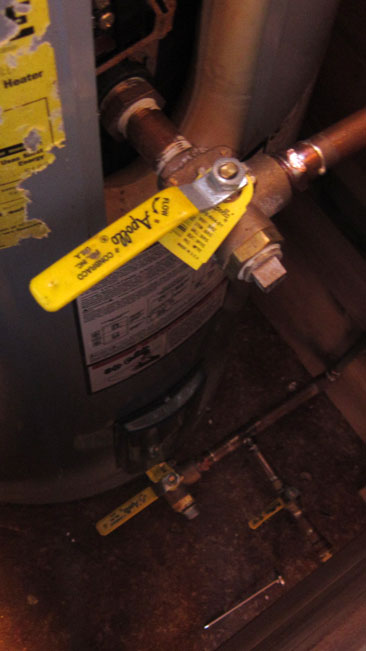
Looking down the tank: I've used the existing drain port as the cold water outlet which feeds the pump and the array (a drain is Y'ed off of that so I can still drain the tank). The returning water is fed back into what was the top heating element port. Both ports of the solar loop AND the hot water outlet are fitted with 3 way valves that will allow me to divert flow to a second tank in the summer when the array would overheat a single tank.
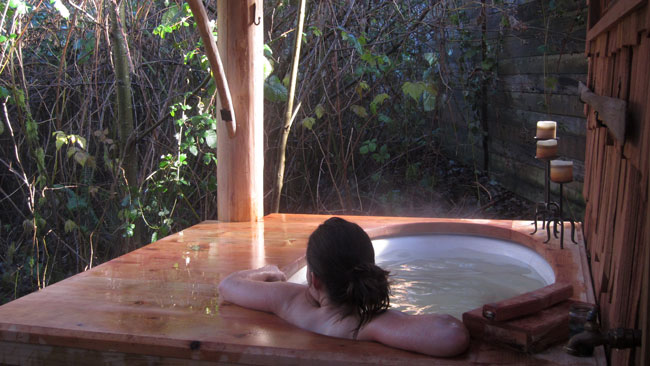
The tub itself is a 70 gallon oval fiberglass soaking tub. It was tempting to install a larger tub but the reality is that a standard sized hot tub takes a huge amount of wood or solar hot water to heat, which means that it's likely to be used much less. This tub takes 80 minutes to heat to 105 degress and uses about 12 pieces of wood the size of your forearm to get there. This is a huge improvement over the standard Chofu setup which normally incorporates a metal or plastic stock tank and takes hours and hours to heat while devouring firewood and bleeding lots of waste heat into the air. The smaller oval soaking tub is the perfect size to allow a deep pleasant soak for two while being parsimonious with water and energy. It's spacious enough to allow to friendly but non-intimate people to feel like they have enough space each. The tub itself is elevated to allow the proper thermosyphon circulation from the Chofu. Much thought went into the placement of the ports and the cubic volumes of both bathers and water. The ports had to be high enough to allow the thermosyphon to work, but low enough to allow two people to enter and exit without exposing the top port which would effectively stop the thermosyphon and destroy the Chofu. The overflow drain is blocked off.
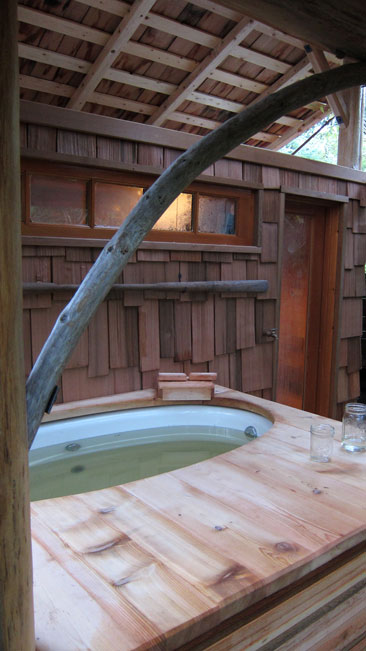
The fiberglass soaking tub is cased in salvaged cedar to give a wooden look-and-feel. I opted not to build a traditional wooden Japanese soaking tub because it didn't use the space or water nearly as efficently and it would have been a big expensive pain-in-the-ass to build. The small wooden box at the lip of the tub hides two full-port ball valves that shoot water against a carefully hand sculpted wooden diverter that fills the tub with a pleasant waterfall. It took a while to get that right! You also might notice a Greenland paddle (of course) that is used to stir the hot water before climbing in.
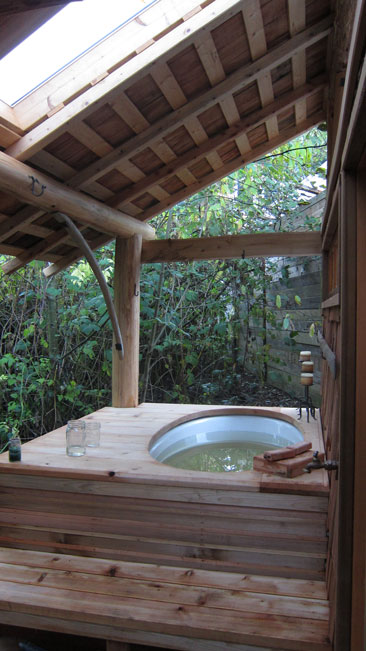
A used acrylic skylight I bought off of craigslist balances the light and brightens the tub area.
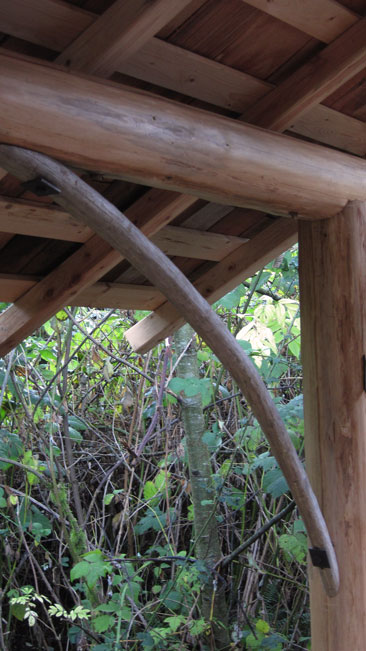
Most of the sheer (resistance to racking and swaying in the wind) in this structure is captured by the plywood sheathing covering the enclosed room, but I added a few braces externally for a little extra stiffness. These braces were curved branches that dipped low over the river and because they are whole limbs, they are much stronger than sawn timbers which would need to be larger to achieve the same strength.
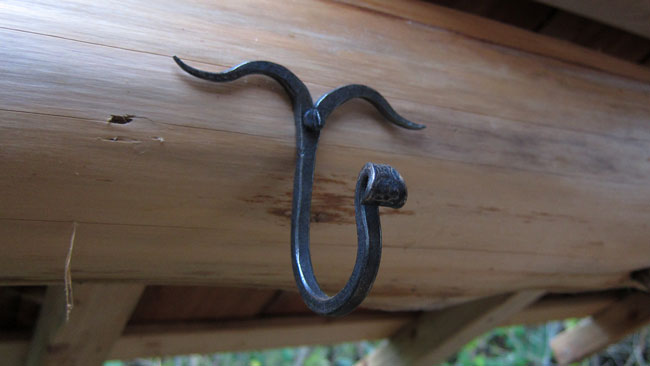
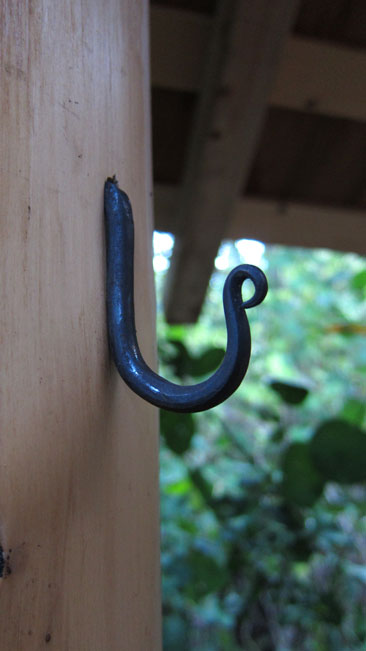
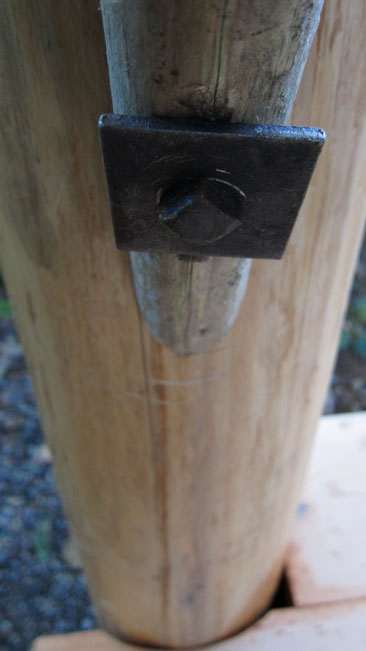
An abundance of hand-forged iron hooks compliments the aesthetic of the structure and gives a place to hang towels and clothes. Black iron square head bolts and square plates add to that look.
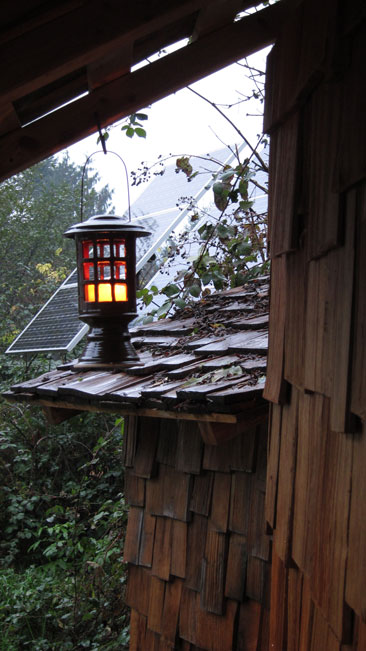
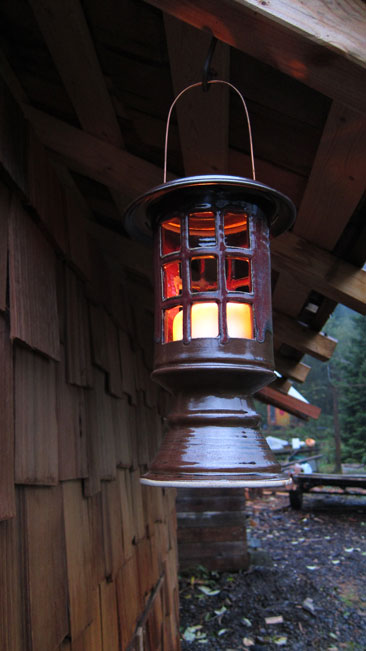
A handmade clay lantern gives the perfect finishing touch and helps bathers find the entrance on a dark night.
Final thoughts:
The bath house exceeds my expectations in every way. It's beautiful and uses very little fuel and energy while providing a first-class relaxing soak. I love the "free lunch" that comes with enclosing the Chofu, and I can't wait until summer when those rickety old solar panels are blasting out the hot water. I've been building with salvage panels for a few years and it never ceases to amaze me how much hot water these decrepit 1970's era panels can make. Solar hot water should be federally mandated on all buildings, period. It's much more fiscally sensible than financing energy-wars halfway across the planet when free energy is literally pouring out of the sky right here at home. We produce half our hot water here at the farm from the sun and we live on the north facing slope of a rainforest.
I can't say that the technology mix here is the absolute cheapest or easiest solution to make a tub of hot water. Those pumps and gauges and valves ended up costing a LOT more that I'd expected and there are some issues. The magnet in the Laing ecocirc pump collects ferrous particles from rusty old tank and will require the installation of a prefilter to prevent those from destroying the pump. The Chofu cannot be directly integrated with the pressurized hot water which is annoying but not that big of a deal. When it comes to open loop salvaged solar hot water systems it's really hard to beat a no-pump thermosyphon setup like the one we use in the main house. A lot of money is saved on expensive widgets. A second thermosyphon loop can be run from the elevated tank down to a copper coil in the chimney of an inexpensive steel stove which would blast out good btu's for a sauna. In this type of system both heat sources are integrated in the same tank. In the summer the hot water comes from the sun, in the winter from wood, and in the shoulder seasons it's a perfect mix.
Don't get me wrong, the current setup works really well and I always enjoy tinkering with off-grid energy concepts. Most importantly it's every bit what we needed to keep our sanity intact out here on the farm. In some way it is the keystone I've been needing to feel a sense of completion out here and I'm looking forward to sharing it's magic with our guests this coming year. Starting in 2012 we will be renting out the Japanese Forest House for overnight stays and use of the bath comes with that package. Come see it for yourself and enjoy a long soak under the stars by candle light.
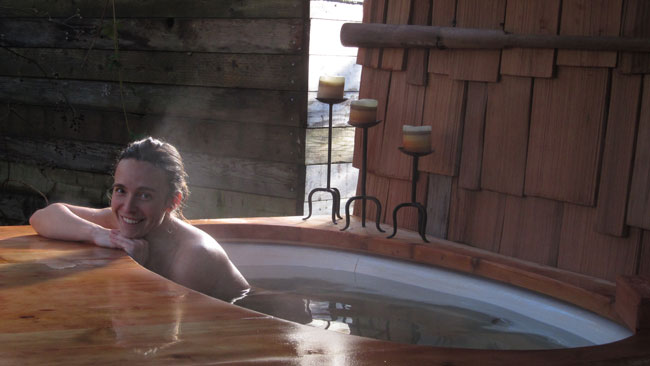
(Leann, thanks for being our bath model!)
Back to Cape Falcon Kayak